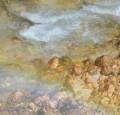
DMT-Nexus member

Posts: 2147 Joined: 09-May-2009 Last visit: 08-Jan-2026 Location: the shire, England
|
MYCELIATED GRAIN TEK It has been found that the mycelium of certain species of potent psilocybin-bearing mushrooms of the genus Psilocybe also produces considerable quantities of active material when cultivated on sterilized, edible grain media (or “grain-spawn”). The grain-spawn is inoculated and incubated in glass canning jars or polyurethane bags specially designed to tolerate sterilization temperatures. The resulting myceliated grain is then dehydrated and easily preserved long-term if properly stored. The whole dried kernels may be simmered in water to create a potent tea, or ground to create an easily digestible flour (depending on the particular grain used). The two species known with certainty to produce active compounds in sufficient quantity are Psilocybe caerulescens, and Psilocybe hoogshagenii/semperviva, though it's likely that many others may be found to be equally effective once further research has been conducted. Ps. zapotecorum and Ps. mexicana are worthy candidates for experimentation. This method negates the need to fruit mushrooms, which can be costly, time-consuming and generally unfavorable to those without sufficient motivation or patience, particularly in the case of the lesser-known and temperamental psilocybin mushrooms such as Ps. caerulescens. The process is considerably simpler, lower maintenance, less time consuming, and more discrete than fruiting mushrooms. It requires minimal equipment or expensive tools, and results in very high-quality material with little waste or environmental impact. Production requires little space, is easily scaled to suit the specific needs of the cultivator, and the quantity of inoculated material does not change the incubation time required for maximum potency. There is no need for a fruiting apparatus or incubator, and a flow-hood or glove-box is not required when a sterile liquid culture syringe is employed skillfully using filter lids fitted with self-healing injection ports. The creation of these lids requires a moderate level of patience and competency, but with tools readily obtained online or from a typical hardware store, dozens of durable, reusable lids may be created in a single afternoon. The lids are fastened on regular-mouthed or wide-mouthed glass canning jars, which serve as the final incubation vessels. Wide-mouthed jars are preferred for performing grain-to-grain inoculations. Once the grain has been inoculated, there is no need for further maintenance such as misting and fanning, so the grain jars or bags may be left unattended for extended periods of time without risk of failure. The substrate (hydrated grain) must be sterilized to ensure that competitor fungi and bacteria are eliminated before inoculating with the desired fungi. A pressure-cooker/canner capable of reaching temperatures necessary for rapid full sterilization will greatly ease the process and virtually eliminate the possibility of contamination when pure starting media is used, and when aseptic technique is followed correctly. However, sterilization by means of a pressure-canner is not required. Alternatively, a somewhat more tedious but sufficiently effective process called “fractional sterilization” or “Tyndallization” may be employed. This involves the staged immersion of jars in boiling water/steam in intervals over the course of three days. All that is required for this sterilization technique is a large pot with a well-fitting lid. Pure starting media is of critical importance for this method, as any contamination present in the master inoculant will be transmitted to the media that will ultimately be consumed. Fortunately, it is relatively easy to detect contamination on grain-spawn. Foul-smelling jars, or grain with visible signs of mold or bacteria should be discarded. Only grain with visibly healthy white mycelium and a typically “mushroomy” smell should be used, and only in the complete absence of doubt. The three most common starting media are spore-prints (mushroom spores stored in a tin-foil envelope), liquid culture (mycelium suspended in liquid nutrient media stored in a sterile syringe), and agar culture (mycelium grown on seaweed gelatin and stored in a petri dish, sterile test-tube or plastic baggie). Liquid culture syringes are preferred for this TEK as they can be expanded without the need for a sterile environment (such as a flow-hood or glove-box). Filter lids with self-healing injection-ports permit the application of liquid culture in open air. Spores on the other hand must be transferred and “cleaned” on sterile agar media, which can only be performed in a sterile environment. Likewise, agar cultures can only be expanded (to agar or liquid culture) in sterile conditions. In this tutorial, various modes of preparing nutrient media will be described in detail. It is warranted that at least a glove-box be created or obtained in order to permit the long-term storage and preservation of these rare and valuable species of fungi. Due to the legality and discrete nature of spore-prints, they will undoubtedly be the most common and sustainable mode of transferring the genetics through the mail (though a method for sending agar culture via standard lettermail will be described at the end of this manual). In order to sustain the demand for these rare fungi species, it will be necessary to fruit the mushrooms and obtain spore prints, therefore learning to cultivate the mushrooms themselves is strongly encouraged by the writers of this TEK. Ps. hoogshagenii/semperviva is quite simple to cultivate, and provides mushrooms of unparalleled quality. Some useful links with information regarding the cultivation of Ps. hoogshagenii/semperviva are included on the last page of the attached manual. Enjoy! 
|
|
|
|
|

DMT-Nexus member
Posts: 1222 Joined: 24-Jul-2012 Last visit: 10-Jul-2020
|
Yea, I've thought about this myself. Considering the myc can become so glaringly blue there must be a decent amount of alkaloids in the myc. We need to do alkaloid profiles on fruit vs myc Cool idea. I'll stick with fruits for now  "Think more than you speak"
"How do you get rid of the pain of having pain in the first place? You get rid of expectations"
"You are everything that is. Open yourself to the love and understanding that is available."
"To see God, you have to have met the Devil."
"When you know how to listen, everyone becomes a guru."
" One time, I didn't do anything, and it was so empty... Almost as if I wasn't doing anything. Then I wrote about it. It was fulfilling."
|
|
|

In the gap between thoughts nonconceptual wisdom shines continuously.
Posts: 207 Joined: 16-Sep-2017 Last visit: 11-Mar-2024 Location: ⚗ alembic ⚗
|
Thank you for this great idea! I have plans to try to cultivate Psilocybe serbica/bohemica and would be very interested in trying this method with the mentioned species. Also I think this can be a great introduction for me to mushroom cultivation since I have very limited experience in the field. 
|
|
|

DMT-Nexus member
Posts: 113 Joined: 24-Jun-2017 Last visit: 11-Nov-2024
|
Very interesting. I have to admit that I have never heard of this technique. Is there any anecdotal data on potency of this grain material or on the potency as compared to the fruits?
I was working with grain just last night and nearly munched some for S&G but I want sure how active it was, if active at all!
|
|
|

DMT-Nexus member

Posts: 2147 Joined: 09-May-2009 Last visit: 08-Jan-2026 Location: the shire, England
|
Hey DeDao, I/we can confirm that are indeed decent amounts of psilocybin/alkaloids in the mycelium, and using mycelium-grain is definitely a viable means of ingesting psilocybin. It would good indeed to see alkaloid comparisons made between the mycelium and the mushrooms, but from our experiments so far we can conform that the mycelium is in no way lacking in mojo compared to the mushrooms (also worth remembering that the mushrooms themselves are effectively coagulated mycelium). My hunch (which requires further testing) is that the mycelium-grain will also provide a more standardised concentration of psilocybin than the mushrooms which can vary markedly in potency. Triglav, I definitely think this method is particularly applicable to the more potent species...I'm curious about P. azurescens...I'm wondering whether the woodlover paralysis occasionally reported could be something to do with the woody substrate, which may be avoided if growing mycelium on grain. When growing shamanically revered non- Cubensis species (such as P. hoogshagenii, P. caerulescens and P. zapotecorum) they can take months to fruit, may be trickier to fruit than Cubensis, and are lower yielding. This approach makes otherwise inaccessible species accessible, it's easier, lower maintenance, cheaper, quicker, more discrete, high yielding and can easily be scaled up to the individual needs of the cultivator. Loverofallthings, the dried P.hoogshagenii/Semperviva mycelium grain is roughly equivalent to 1g dry of Cubensis at a level table spoon dosage...more work is required with different Psilocybe species, grain type and incubation time to see how these affect potency, but we've found rice and oats to work really well, and a 2 month incubation time is sufficient, and maybe shorter. P. hoogshagenii, P. caerulescens and P. zapotecorum all seem like promising species, given their potency and their possessing tenacious and fast growing mycelium (unlike the mushrooms), but it would be good to see wider experimentation with other species...work is very much ongoing! 
|
|
|

DMT-Nexus member
Posts: 113 Joined: 24-Jun-2017 Last visit: 11-Nov-2024
|
Wow. Very excellent information. I did not know that the mycelium was active, it was only a hopeful hunch.
|
|
|

DMT-Nexus member

Posts: 3090 Joined: 09-Jul-2016 Last visit: 03-Feb-2024
|
This is very interesting indeed. I would be particularly interested in the alkaloid content of p.mexicana mycelium.
I believe here are plenty of mexicana growkits available, but they contain a mexicana strain that is especially bred to produce truffles. Growing mushrooms from these strains is extremely difficult and even very experienced mushroom growers only manage to grow tiny amounts of mushrooms from them.
The mexicana truffles themselves are pretty mediocre. But it would be worth finding out how potent the mycelium is.
|
|
|

DMT-Nexus member
Posts: 113 Joined: 24-Jun-2017 Last visit: 11-Nov-2024
|
Bancopuma: is that measurement a dehydrated and ground up tablespoon, or a wet fresh whole grain tablespoon?
|
|
|

DMT-Nexus member

Posts: 2147 Joined: 09-May-2009 Last visit: 08-Jan-2026 Location: the shire, England
|
Hey dragonrider, I have some P. mexicana 'Chicon Nindo' LC almost ready to go, so I'll be inoculating some grain jars to test it out (already have some P. hoogshagenii and P. caerulescens grain, with P. zapotecorum LC colonising). My hunch is that the Mexicana won't likely be as potent as these other species perhaps but I feel it will definitely be worthwhile. But yes this approach definitely offers an alternative to truffles, and the number of species one can explore. P. tampanensis and P. galindoi have been found through genetic analyses conducted a few years back to be substrain variants of P. mexicana, and they are easy to fruit and can be quite high yielding...most people who have sampled the mushrooms of these consider them vastly superior and a lot more potent than the truffles themselves.
Loverofallthings, the measurement refers to a level tablespoon of dried whole grain (of the P. hoogshagenii)...if ground it will likely be more slightly more potent due to being denser. A level teaspoon of the ground mycelium-grain powder is a good amount for a microdose (but perhaps slightly more than what would be considered a microdose).
|
|
|

DMT-Nexus member
Posts: 545 Joined: 02-Dec-2017 Last visit: 07-Jun-2025 Location: right side of the river
|
I thought that it is common knowledge that mycelium contains alkaloids, and that you can use colonized grain culture (or any other form of non fruiting mycelium) to produce entheogenic effects.
Only disadvantage is low yield. There is quite small amount of mycelium in grains.
But considering problems with fruiting when growing many species of Psilocybe, this is a good way.
|
|
|

DMT-Nexus member

Posts: 2147 Joined: 09-May-2009 Last visit: 08-Jan-2026 Location: the shire, England
|
Hi doubledog, I was definitely aware that mycelium was a source of psilocybin/alkaloids, but I was under the impression that it was at concentrations that rendered it a non viable source of the latter. Even with my limited experimentation I can say that this is definitely not the case, and that producing mycelium on edible grain alone is definitely a viable means of producing psilocybin, particularly when using more potent species that may otherwise take a long time to fruit, be tricky to fruit, or be low yielding. Yes mycelium is only a small component of the grains (actually hinting it iss really quite potent by weight) but once cultivation is scaled up, I feel the overall yields are far from trivial (if using multiple grain jars or grow bags).
|
|
|

DMT-Nexus member
Posts: 545 Joined: 02-Dec-2017 Last visit: 07-Jun-2025 Location: right side of the river
|
Definitely, for practical purposes, scaling up is really necessary.
|
|
|

DMT-Nexus member

Posts: 2147 Joined: 09-May-2009 Last visit: 08-Jan-2026 Location: the shire, England
|
Some photos of brown rice inoculated with P. hoogshagenii/semperviva and incubated for 2 months. Notice the intensity of the blueing reaction of the dried grain on drying. The latter species appears to be particularly promising when it comes to this approach, and the mushrooms themselves are easy to fruit and are very potent (and held in great shamanic reverence by a number of indigenous groups in Mexico). Definitely a very interesting species worthy of far more attention than it currently receives. Bancopuma attached the following image(s):  grain jars.JPG (182kb) downloaded 457 time(s). drying grain.jpg (334kb) downloaded 453 time(s). drying grain_2.jpg (297kb) downloaded 458 time(s).
|
|
|

DMT-Nexus member

Posts: 1760 Joined: 28-May-2009 Last visit: 10-Oct-2024
|
You have definitely sparked my interest, Banco! Wonderful way to make difficult to cultivate strains accessible to the average grower. I too would be curious to see how p. azurescens would turn out, as well as other wood loving species.
|
|
|

DMT-Nexus member
Posts: 118 Joined: 16-Sep-2017 Last visit: 30-May-2023
|
This is very interesting. Could there be an issue, specifically with new growers, of ingesting something dangerous that they believe is psilocybe mycelium? I didn’t read the whole pdf yet but didn’t see this brought up on the thread. Just something to think about. And you will come to find that we are all one mind
Capable of all that's imagined and all conceivable.
|
|
|

DMT-Nexus member

Posts: 2147 Joined: 09-May-2009 Last visit: 08-Jan-2026 Location: the shire, England
|
Hey JP, this is a good point to raise, and is discussed in the TEK. When growing fungal mycelium (speaking from experience), molds or bacteria tend to be obvious...both visually, and by smell in comparison to the fungal mycelium, and so are easily identified. Any grain that is suspected of being infected should be discarded. In addition, one can always prepare the mycelium grain as a tea prior to ingestion (we recommend a gentle simmering for 20 minutes), and this should provide an extra level of safety. Medicinal mushrooms are often grown on sterile grain media like brown rice and many mushroom products contain mycelia on finely ground or “micronized” brown rice substrate.
|
|
|

witch
Posts: 487 Joined: 06-Dec-2015 Last visit: 06-Feb-2024 Location: the neon forest
|
An interesting experiment. I wonder about the motivations though. It would seem that using mycelium extract is the preferred technology for legal mushroom actives in industrial pharmacology, given how it scales really well, and is relatively cheap and simple. So if someone wanted to produce enough psilocybin to get all of North America high, this certainly is the way to go, along with water-based extraction of the actives to produce a concentrate. It's an industrial method, in all senses of the word. If quantity is the name of the game, this is the tek for you. I wonder however about its purported suitability for beginners. You don't need a still air box? Yea, so where are you gonna get your LC from? How are you going to perpetuate your grow without spore printing and / or agar cloning? You can't G2G forever, and you most definitely can't G2G without a still air box. It's an unsustainable, pure consumer tek in its "easy for beginners" iteration, and for that it has earned my contempt. Do you believe in the THIRD SUMMER OF LOVE?
|
|
|

DMT-Nexus member

Posts: 2147 Joined: 09-May-2009 Last visit: 08-Jan-2026 Location: the shire, England
|
If you were to read the introduction to the tek, you would see that cultivation of mushrooms is encouraged (particularly of P. hoogshagenii/semperviva, which is a resilient and easy to fruit species, producing highly potent mushrooms that are held in great reverence by indigenous Mexican groups and growers alike and is certainly worthy of more attention than it currently receives). I think the comments about this being a consumer tek and unsustainable are silly and unwarranted. This grain tek approach is lower input (in terms of both resources and energy) than fruiting mushrooms. And this shouldn't be classified as an "industrial method"...that is only if it is applied in an industrial context, which only you are making the claim for. It's interesting to note that scientists have recently succeeded in genetically engineering E. coli to produce psilocybin in large amounts, and I can't help but wonder if this isn't simpler however. In modern trials psilocybin is chemically made in a lab to high purity rather than being extracted from fungal mycelium.
This certainly isn't presented in a manner to try and supplant mushroom growing in any way, which I think you'd understand if you'd read the introduction to the guide. People are encouraged to fruit their own and hopefully disseminate the prints, and this will be all the more important if using these other more potent (and hard-to-find) species. I don't think it's all about quantity of psilocybin either...if it were so, bulk growing P. cubensis would likely still be preferable for many. There may be a facet of quality here too...as this mycelium grain approach allows one to easily cultivate otherwise difficult to fruit, slow growing or low yielding species held in great reverence by Mexican indigenous Psilocybe using groups, as well as experienced growers. I don't think it's a bad thing having more options available in terms of accessible Psilocybe species people can cultivate.
I definitely agree that a still air box or better yet a glove box will be a necessity for some parts of the process...again, this is mentioned in the tek, which you would know if you had read the introduction. I built a glove box a while back which I use for inoculations which wasn't difficult to do.
I think if you'd actually glanced at the tek, or skim read the introduction, you'd probably realise you don't really have any basis to feel contempt for this.
|
|
|

witch
Posts: 487 Joined: 06-Dec-2015 Last visit: 06-Feb-2024 Location: the neon forest
|
No need to get defensive, I think your mycological endeavors are quite noteworthy and incredibly valuable to the community.  I'm sorry for being harsh and antagonistic. I feel strongly about our relationship to fungi, and your opening blurb felt a little like encouraging an irresponsible, speed & quantity above everything attitude. I see far too many "junkies" (as opposed to "psychonauts" ) who are out looking for the quickest, dirtiest way to get the most "drugs" possible. The people who want to make tea from BRF cakes because they can't be bothered to make a SGFC, and similar. I don't like the idea of supporting / giving tools to this crowd. If that wasn't your intention, I take my condemnation back. Do you believe in the THIRD SUMMER OF LOVE?
|
|
|

DMT-Nexus member

Posts: 2147 Joined: 09-May-2009 Last visit: 08-Jan-2026 Location: the shire, England
|
Hey dude, no worries, that definitely wasn't our intent in writing this tek.  And yes I too hold the fungi in great reverence. In terms of overall bulk quantities and speed, I think bulk growing of P. cubensis will still be of more interest to people than this approach. I think one of the key things this tek brings to the table is making some of the more obscure and shamanically revered species of Psilocybe more accessible to people. Very early days, but the mycelium of these species tested so far do not seem to be lacking in mojo in any way in comparison to the mushrooms. The simplicity, low maintenance, low input and low environmental footprint of this tek I don't see as a bad thing either. Once jars are inoculated with LC, they can be left for months at room temperature, and then dried for consumption as and when desired. This hands off approach suits me at the present time, as I'm busy and away a fair bit, and I've learned from repeated experience that one needs to be present when fruiting mushrooms.
|